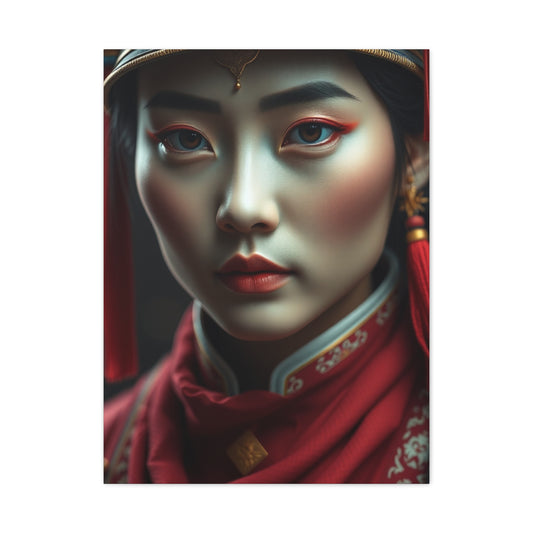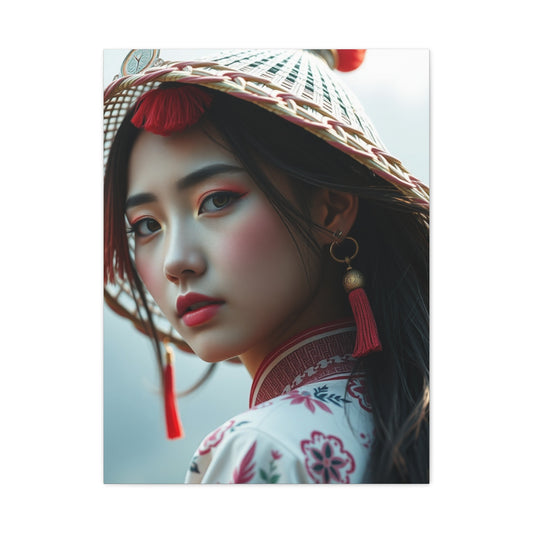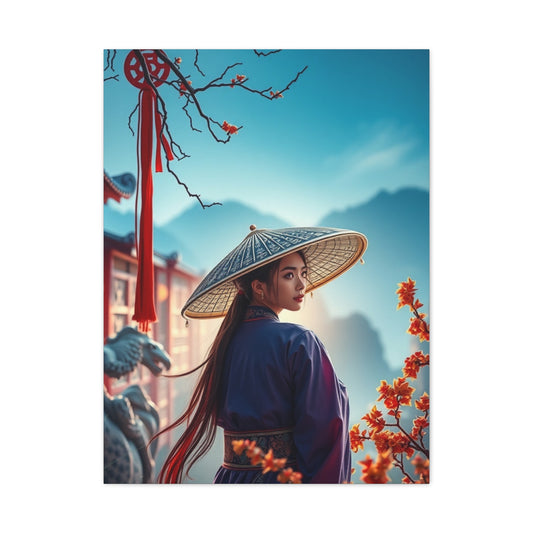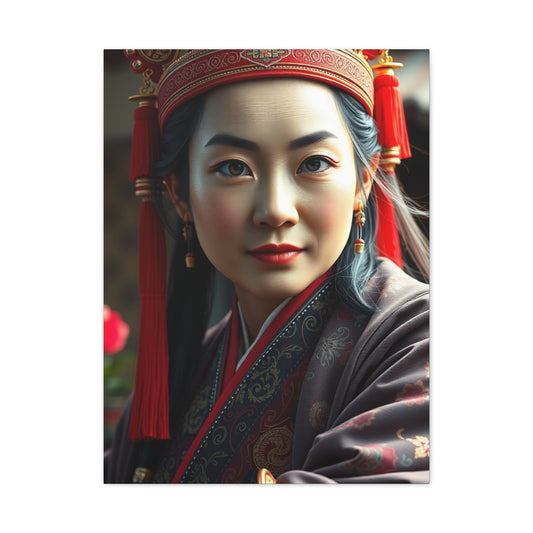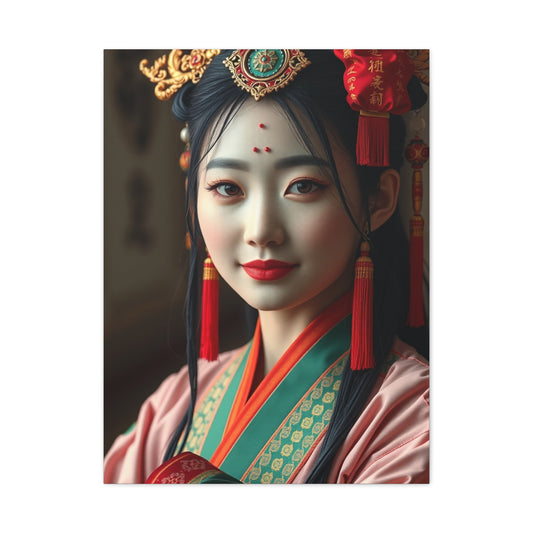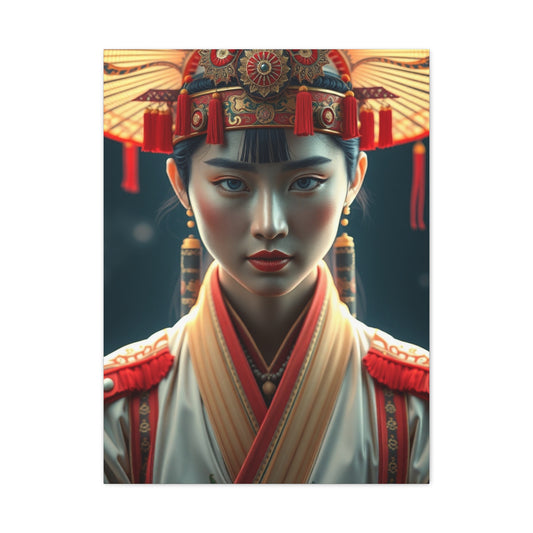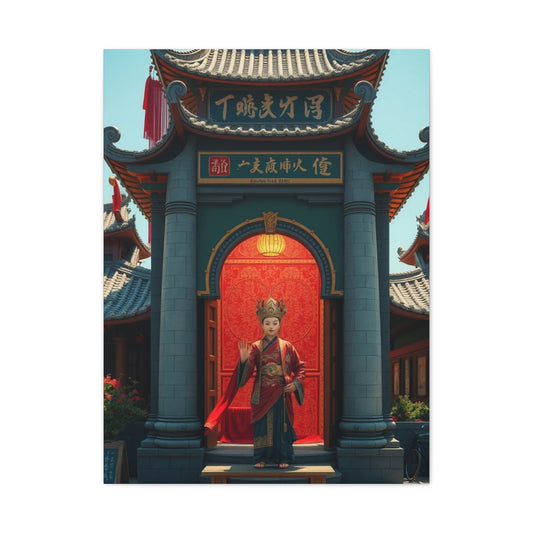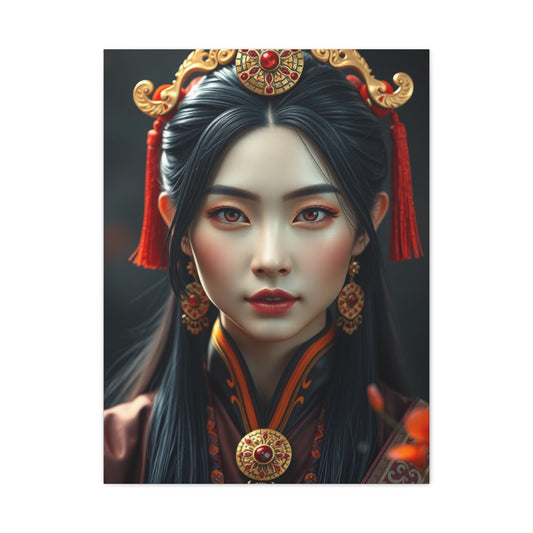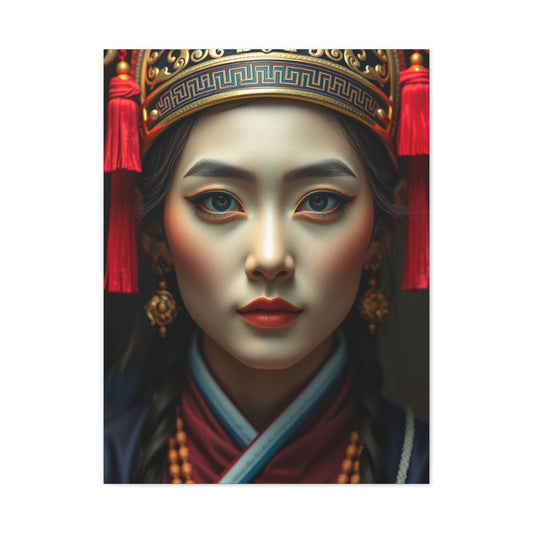Discovering the Tranquil Beauty of Danhui Nai Wall Art
The contemporary art landscape offers countless opportunities for homeowners and interior enthusiasts to express their aesthetic preferences through carefully curated wall decorations. Among the myriad artistic styles available today, Danhui Nai wall art stands as a beacon of tranquility and sophisticated visual appeal. This distinctive artistic approach captures the essence of peaceful living through meticulously crafted compositions that speak to the soul's yearning for serenity.
Danhui Nai wall art encompasses a diverse collection of artistic expressions that prioritize harmony, balance, and emotional resonance. These carefully designed pieces feature gentle color palettes, flowing compositions, and subject matter that evokes feelings of calmness and contemplation. The artistic philosophy behind these works centers on creating visual experiences that serve as sanctuaries from the chaotic pace of modern life.
The appeal of Danhui Nai wall art extends beyond mere aesthetic pleasure. These pieces function as emotional anchors within living spaces, providing occupants with daily doses of visual tranquility that can significantly impact mood and overall well-being. The subtle interplay of colors, textures, and compositional elements creates an atmosphere of refined elegance that enhances any interior design scheme.
Contemporary collectors and interior designers increasingly recognize the transformative power of thoughtfully selected wall art. Danhui Nai pieces offer a unique solution for those seeking to create environments that promote relaxation, reflection, and rejuvenation. The artistic techniques employed in these works demonstrate a deep understanding of color theory, spatial relationships, and the psychological impact of visual elements.
The versatility of Danhui Nai wall art makes it suitable for various interior design styles, from minimalist modern apartments to traditional family homes. This adaptability stems from the timeless quality of the artistic approach, which transcends fleeting design trends to offer enduring aesthetic value. The careful attention to detail evident in each piece ensures that these artworks continue to captivate viewers long after their initial installation.
Understanding the cultural and artistic context of Danhui Nai wall art enhances appreciation for these remarkable pieces. The artistic tradition draws inspiration from various sources, including natural landscapes, cultural motifs, and contemporary design principles. This rich foundation provides depth and meaning to each artwork, creating pieces that offer both immediate visual impact and lasting intellectual engagement.
The production quality of authentic Danhui Nai wall art reflects a commitment to excellence that distinguishes these pieces from mass-produced alternatives. Premium materials, archival printing processes, and meticulous quality control ensure that each artwork maintains its visual integrity over time. This attention to craftsmanship justifies the investment in genuine pieces and guarantees long-term satisfaction for collectors.
Revolutionary Impact of Danhui Nai Artwork on Contemporary Living Environments
The integration of Danhui Nai artwork into residential and commercial spaces represents a paradigm shift in how we conceptualize interior decoration and environmental psychology. These carefully crafted pieces possess an extraordinary ability to fundamentally alter the atmosphere of any room, transforming ordinary spaces into havens of tranquility and sophisticated elegance.
The psychological impact of Danhui Nai artwork extends far beyond surface-level aesthetics. Research in environmental psychology consistently demonstrates that visual elements within our living spaces profoundly influence our emotional states, stress levels, and overall quality of life. Danhui Nai pieces leverage these principles through their masterful use of calming color schemes, balanced compositions, and nature-inspired imagery that triggers positive psychological responses.
The color psychology embedded within Danhui Nai artwork plays a crucial role in its transformative power. Soft blues evoke feelings of peace and stability, while gentle greens connect viewers to nature's restorative qualities. Warm earth tones create feelings of security and comfort, while subtle neutrals provide a sophisticated backdrop that allows other design elements to shine. This thoughtful approach to color selection ensures that each piece contributes positively to the overall emotional tenor of the space.
Compositional elements within Danhui Nai artwork demonstrate a deep understanding of visual flow and spatial harmony. The strategic placement of focal points guides the viewer's eye through the piece in a manner that promotes relaxation rather than visual tension. This careful attention to compositional balance creates artwork that serves as visual meditation, offering viewers a respite from the visual chaos often present in modern environments.
The scale and proportion considerations inherent in Danhui Nai artwork make these pieces particularly effective at transforming living spaces. Larger pieces can serve as commanding focal points that anchor entire rooms, while smaller works can be grouped to create intimate vignettes that add personality and charm to specific areas. This flexibility allows homeowners to customize their approach based on their unique spatial requirements and design preferences.
The versatility of Danhui Nai artwork enables seamless integration into diverse architectural styles and design schemes. Whether adorning the walls of contemporary lofts, traditional family homes, or transitional spaces that blend multiple design elements, these pieces adapt gracefully to their surroundings while maintaining their distinctive character. This adaptability stems from the timeless quality of the artistic approach, which emphasizes universal themes of beauty, tranquility, and harmony.
The lighting interaction with Danhui Nai artwork creates dynamic visual experiences that change throughout the day. Natural light reveals subtle details and color variations that may not be apparent under artificial illumination, while strategic accent lighting can dramatically enhance the artwork's impact during evening hours. This responsiveness to lighting conditions adds an element of temporal beauty that keeps the artwork engaging over time.
The acoustic properties of spaces featuring Danhui Nai artwork often seem improved, though this effect is primarily psychological. The calming visual environment created by these pieces can make occupants more aware of pleasant sounds while reducing sensitivity to jarring noise. This synesthetic effect demonstrates the holistic impact that thoughtfully selected artwork can have on our perception of our living environments.
Selecting the Ideal Danhui Nai Wall Art for Your Personal Sanctuary
The process of choosing the perfect Danhui Nai wall art for your home requires careful consideration of multiple factors that extend beyond simple aesthetic preferences. Understanding how different pieces will interact with your existing decor, lifestyle, and personal emotional needs ensures that your investment will provide lasting satisfaction and meaningful enhancement to your living space.
Room functionality plays a pivotal role in determining which Danhui Nai pieces will work best in specific areas of your home. Bedrooms benefit from artwork that promotes relaxation and peaceful sleep, making pieces with soft, muted colors and gentle imagery ideal choices. Living rooms and family gathering spaces can accommodate more vibrant pieces that encourage conversation and social interaction while maintaining the calming aesthetic characteristic of Danhui Nai work.
The architectural features of your space significantly influence artwork selection decisions. Rooms with high ceilings can accommodate larger pieces or vertical arrangements that draw the eye upward and emphasize the spatial grandeur. Spaces with lower ceilings benefit from horizontal pieces that create the illusion of expanded width and prevent the room from feeling cramped or confined.
Natural light availability in each room affects how Danhui Nai artwork will appear throughout different times of day. Pieces with cooler color palettes may appear overly subdued in north-facing rooms with limited natural light, while warmer tones can help compensate for this limitation. South-facing rooms with abundant natural light can successfully showcase the full range of Danhui Nai pieces, as the varied lighting conditions will reveal different aspects of the artwork's complexity.
The existing color scheme of your space should harmonize with your chosen Danhui Nai pieces rather than compete with them. Neutral walls provide the most flexible backdrop for these artworks, allowing their subtle color variations to take center stage. Rooms with bold wall colors require more careful selection to ensure the artwork enhances rather than clashes with the existing palette.
Personal lifestyle considerations influence which Danhui Nai pieces will provide the most satisfaction over time. Families with young children might prefer pieces mounted at appropriate heights and protected by quality framing, while empty nesters may have more freedom to experiment with different placement options and arrangements. Pet owners should consider the durability of framing materials and the accessibility of artwork to curious animals.
The emotional resonance of specific Danhui Nai pieces varies among individuals based on personal experiences, cultural background, and aesthetic preferences. Taking time to observe how different pieces make you feel during various moods and times of day can help identify works that will provide long-term emotional satisfaction. This personal connection to the artwork ensures that it will continue to bring joy and comfort for years to come.
Budget considerations should encompass not only the initial purchase price but also framing, installation, and potential future expansion of your collection. Investing in quality framing for Danhui Nai pieces protects your investment while enhancing the artwork's visual impact. Planning for future additions allows you to create cohesive collections that grow organically over time.
The size relationships between multiple pieces require careful planning when creating grouped arrangements. Danhui Nai artwork works beautifully in various configurations, from symmetrical pairs to asymmetrical clusters that create visual interest through varied scales and proportions. Understanding these relationships helps create arrangements that feel intentional and professionally curated.
Profound Emotional Resonance of Danhui Nai's Peaceful Artistic Vision
The emotional impact of Danhui Nai's peaceful art extends far beyond conventional decorative purposes, reaching into the realm of therapeutic visual experience that can profoundly affect viewers' psychological and emotional well-being. These carefully crafted pieces serve as visual medicine, offering daily doses of tranquility that counteract the stress and anxiety prevalent in contemporary life.
The neurological response to peaceful visual stimuli has been extensively studied, revealing that exposure to calming imagery can trigger the release of neurotransmitters associated with relaxation and well-being. Danhui Nai artwork leverages these biological responses through its masterful use of soft color transitions, organic forms, and compositional elements that promote mental relaxation. The visual rhythm created by these pieces encourages a meditative state that can help reduce cortisol levels and promote overall emotional balance.
The symbolic content within Danhui Nai artwork often draws from universal archetypes that resonate across cultural boundaries. Natural elements such as flowing water, gentle landscapes, and peaceful skies tap into deeply embedded human associations with safety, renewal, and spiritual connection. These symbolic references create emotional bridges between the artwork and viewers' unconscious minds, fostering feelings of comfort and belonging.
The temporal aspect of engaging with Danhui Nai artwork contributes to its emotional impact. Unlike digital media that demands constant attention and stimulation, these pieces reward patient observation and contemplation. The longer viewers spend with the artwork, the more details and subtle relationships they discover, creating an ongoing relationship that deepens over time.
The seasonal and cyclical themes often present in Danhui Nai artwork help viewers reconnect with natural rhythms that urban living frequently obscures. This connection to natural cycles provides emotional grounding and perspective that can be particularly valuable during challenging life transitions or periods of uncertainty. The artwork serves as a visual reminder of life's inherent patterns of growth, rest, and renewal.
Color therapy principles embedded within Danhui Nai pieces contribute to their emotional effectiveness. The strategic use of blues promotes mental clarity and emotional stability, while greens foster feelings of growth and harmony. Warm accent colors add touches of optimism and energy without overwhelming the overall peaceful atmosphere. This sophisticated approach to color psychology ensures that the artwork supports positive emotional states.
The cultural resonance of Danhui Nai artwork connects viewers to broader traditions of artistic expression that prioritize spiritual and emotional well-being over purely aesthetic concerns. This connection to meaningful artistic lineages adds depth to the viewing experience and helps establish emotional significance that transcends momentary visual pleasure.
The accessibility of the emotional experience offered by Danhui Nai artwork makes it particularly valuable in our increasingly diverse society. Regardless of cultural background, age, or personal circumstances, viewers can connect with the universal themes of peace, beauty, and tranquility that these pieces embody. This inclusivity makes Danhui Nai artwork an excellent choice for public spaces and shared living environments.
Innovative Gallery Wall Concepts Featuring Danhui Nai Artistic Prints
Creating compelling gallery walls with Danhui Nai prints requires a sophisticated understanding of visual relationships, spatial dynamics, and the unique characteristics that make these artworks particularly suitable for grouped displays. The inherent harmony present in Danhui Nai pieces provides an excellent foundation for creating cohesive arrangements that maintain visual interest while preserving the peaceful atmosphere that defines this artistic style.
The foundation of successful gallery wall design begins with understanding the visual weight and compositional structure of individual Danhui Nai pieces. Unlike eclectic gallery walls that rely on contrast and variety for impact, Danhui Nai arrangements achieve their effect through subtle variations in tone, texture, and subject matter that create gentle visual rhythms across the display surface.
Asymmetrical arrangements of Danhui Nai prints can create dynamic visual interest while maintaining the overall sense of calm that characterizes this artistic style. By varying the sizes and orientations of pieces within the arrangement, designers can create flowing visual paths that guide viewers' eyes across the display in a manner that feels organic and unforced. This approach requires careful attention to balance and proportion to ensure that no single piece overwhelms the others.
Symmetrical gallery wall arrangements featuring Danhui Nai prints offer a more formal approach that emphasizes order and classical proportions. These configurations work particularly well in traditional interior settings or formal spaces where architectural symmetry provides a natural framework for the artwork arrangement. The key to successful symmetrical displays lies in selecting pieces with compatible visual weights and ensuring proper spacing between individual works.
Linear arrangements of Danhui Nai prints create elegant horizontal displays that can effectively span long walls or complement architectural features such as mantels, credenzas, or hallway corridors. These arrangements work best when individual pieces share common elements such as color palette, scale, or thematic content while still providing enough variation to maintain visual interest across the entire display.
Grid-based arrangements offer a contemporary approach to displaying Danhui Nai prints that emphasizes the relationship between individual pieces while creating a cohesive visual statement. This approach works particularly well with series of related works or when combining pieces of similar dimensions. The uniformity of spacing in grid arrangements creates a sense of order that complements the peaceful nature of the artwork.
Mixed media integration allows Danhui Nai prints to be combined with complementary artistic elements such as small sculptural pieces, decorative objects, or even living plants that echo the natural themes often present in the artwork. This approach requires careful consideration of visual hierarchy to ensure that the Danhui Nai pieces remain the focal point of the arrangement while benefiting from the added textural and dimensional interest provided by the supplementary elements.
Color coordination strategies for Danhui Nai gallery walls should emphasize the subtle variations and harmonious relationships present within individual pieces. Rather than strict color matching, successful arrangements often feature pieces that share common undertones or complementary color relationships that create visual cohesion without monotony. This approach allows each piece to maintain its individual character while contributing to the overall aesthetic impact of the arrangement.
Seasonal rotation possibilities allow gallery wall arrangements to evolve throughout the year, reflecting changing moods and seasonal transitions while maintaining the core aesthetic principles that make Danhui Nai artwork so appealing. This approach requires initial investment in a larger collection of pieces but provides ongoing opportunities for refresh and renewal that keep the living space feeling dynamic and engaging.
Contemporary Modern Interior Design
The incorporation of Danhui Nai art into modern interior design schemes requires a nuanced understanding of contemporary design principles and the unique characteristics that make these artistic pieces particularly compatible with current aesthetic trends. Modern interior design emphasizes clean lines, uncluttered spaces, and carefully curated decorative elements that serve both functional and aesthetic purposes.
Minimalist design principles align naturally with the peaceful aesthetic of Danhui Nai artwork. The restrained color palettes and uncluttered compositions characteristic of these pieces complement the minimalist emphasis on simplicity and intentionality. In minimalist interiors, a single large Danhui Nai piece can serve as the primary decorative focal point, providing visual interest without overwhelming the space's clean aesthetic.
Scandinavian design traditions, with their emphasis on natural materials, light colors, and connection to nature, provide an ideal backdrop for Danhui Nai artwork. The organic elements often present in these pieces harmonize beautifully with the natural wood, neutral textiles, and plant-filled environments typical of Scandinavian-inspired interiors. This compatibility creates living spaces that feel cohesive and thoughtfully designed.
Industrial design elements can be softened and humanized through the strategic placement of Danhui Nai artwork. The gentle aesthetic of these pieces provides a counterbalance to the hard edges and raw materials often present in industrial-style interiors. This juxtaposition creates visual tension that adds sophistication and emotional depth to spaces that might otherwise feel cold or unwelcoming.
Mid-century modern interiors benefit from the timeless quality of Danhui Nai artwork, which complements the era's emphasis on bringing natural elements indoors. The organic forms and earth-inspired color palettes often present in these pieces harmonize with the walnut wood, brass accents, and geometric patterns characteristic of mid-century design. This compatibility creates interiors that feel both nostalgic and contemporary.
Contemporary eclectic design approaches allow for creative combinations of Danhui Nai artwork with diverse decorative elements from various cultural and stylistic traditions. The peaceful nature of these pieces provides a unifying aesthetic thread that can help tie together disparate design elements while maintaining visual coherence. This flexibility makes Danhui Nai artwork particularly valuable for homeowners who enjoy experimenting with different decorative styles.
Open floor plan considerations require special attention when integrating Danhui Nai artwork into modern living spaces. The visual relationships between different functional areas must be carefully managed to ensure that the artwork enhances rather than disrupts the flow between spaces. Strategic placement can help define different zones within open layouts while maintaining the overall sense of spatial continuity.
Technology integration in modern homes requires consideration of how Danhui Nai artwork will interact with screens, smart home devices, and other digital elements. The calming nature of these pieces can provide necessary visual relief from the constant stimulation of digital devices, creating balanced environments that support both technological functionality and human well-being.
Designing a Serene Bedroom Wall Art
The bedroom represents our most personal and intimate living space, making it the ideal environment for experiencing the full emotional and psychological benefits of carefully selected Danhui Nai wall art. Creating a serene bedroom sanctuary requires thoughtful consideration of how artwork placement, lighting, and overall design elements work together to promote rest, relaxation, and rejuvenation.
The positioning of Danhui Nai artwork within the bedroom significantly impacts its effectiveness in creating a peaceful atmosphere. Pieces placed directly across from the bed provide a focal point for morning contemplation and evening relaxation, while artwork positioned along the sides of the room creates a sense of visual embrace that enhances feelings of security and comfort. The height at which pieces are hung should accommodate viewing from both seated and reclined positions.
Color psychology takes on particular importance in bedroom applications, where the artwork's emotional impact directly influences sleep quality and morning mood. Danhui Nai pieces featuring cool blues and soft greens promote relaxation and mental calm, making them ideal for placement in primary viewing areas. Warmer tones can be used sparingly as accent elements to prevent the space from feeling cold or unwelcoming.
The scale of bedroom artwork should be proportional to the room's dimensions while considering the intimate nature of the space. Oversized pieces can feel overwhelming in smaller bedrooms, while tiny artworks may appear insignificant in larger rooms. Danhui Nai pieces work particularly well in bedroom settings because their gentle aesthetic prevents even larger works from feeling imposing or disruptive.
Lighting design for bedroom Danhui Nai displays should accommodate both practical needs and aesthetic enhancement. Soft, indirect lighting that illuminates the artwork without creating glare or harsh shadows helps maintain the peaceful atmosphere during evening hours. Dimmer controls allow for adjustment based on time of day and personal preference, ensuring that the artwork contributes positively to the room's ambiance at all times.
The relationship between Danhui Nai artwork and bedroom textiles creates opportunities for sophisticated color coordination and textural contrast. Bedding, curtains, and upholstery can echo colors present in the artwork while introducing complementary textures that add depth and visual interest to the overall design scheme. This coordination should feel natural and unforced, allowing each element to enhance the others.
Privacy considerations in bedroom design affect artwork selection and placement decisions. Pieces visible from external windows or doorways should maintain the room's intimate character while potentially serving as attractive glimpses into the homeowner's aesthetic sensibilities. Danhui Nai artwork's sophisticated yet accessible nature makes it ideal for these semi-public viewing scenarios.
The psychological impact of bedroom artwork on sleep quality and morning mood cannot be overstated. Danhui Nai pieces that evoke feelings of peace and contentment can help establish positive mental associations with the bedroom environment, supporting healthy sleep habits and more pleasant awakening experiences. This therapeutic aspect of bedroom artwork selection makes the investment in quality pieces particularly worthwhile.
Harmonious Blending of Danhui Nai Prints with Diverse Artistic Styles
The sophisticated aesthetic of Danhui Nai prints provides an excellent foundation for creating eclectic art collections that maintain visual cohesion while incorporating diverse artistic styles and cultural influences. The peaceful nature of these pieces allows them to serve as unifying elements that help bridge differences between more assertive or contrasting artworks.
Abstract expressionist pieces can be successfully paired with Danhui Nai prints when color relationships are carefully managed. The emotional intensity of abstract works can be balanced by the calming influence of Danhui Nai pieces, creating arrangements that offer both visual excitement and peaceful respite. This combination works particularly well in spaces where occupants desire both stimulation and relaxation at different times.
Photographic artwork shares compositional and tonal similarities with many Danhui Nai pieces, making them natural partners in mixed arrangements. Black and white photography can provide striking contrast while maintaining thematic coherence, particularly when landscape or nature subjects are featured. Color photography should complement rather than compete with the subtle palettes characteristic of Danhui Nai work.
Contemporary digital art can be integrated with Danhui Nai prints to create arrangements that acknowledge both traditional and cutting-edge artistic expressions. The key to successful integration lies in finding common ground through subject matter, color relationships, or compositional elements that create visual dialogue between the different artistic approaches.
Vintage and antique artworks can be paired with Danhui Nai pieces to create arrangements that span different historical periods while maintaining aesthetic coherence. The timeless quality of peaceful imagery transcends specific artistic eras, allowing pieces from different periods to coexist harmoniously when other visual elements support the relationship.
Cultural art from different traditions can be incorporated into arrangements featuring Danhui Nai prints when common themes or visual elements provide connecting points. Natural motifs, peaceful expressions, and harmonious color relationships can bridge cultural differences and create globally inspired arrangements that feel cohesive rather than scattered.
Three-dimensional art elements such as small sculptures, ceramic pieces, or textile works can add depth and textural interest to wall arrangements anchored by Danhui Nai prints. These additions should complement rather than compete with the two-dimensional pieces, often working best when they echo similar themes or aesthetic qualities present in the primary artworks.
The proportion and scale relationships between different artistic styles require careful consideration to maintain visual balance. Danhui Nai pieces can serve as moderating influences that help integrate more dramatically scaled or visually aggressive artworks into cohesive arrangements. This mediating quality makes them particularly valuable in eclectic collections.
Displaying Danhui Nai Artwork
Creating beautiful displays of Danhui Nai artwork doesn't require unlimited financial resources when approached with creativity, strategic planning, and understanding of cost-effective alternatives that maintain quality while respecting budget constraints. Smart shoppers can build impressive collections and create stunning displays through careful research and resourceful implementation strategies.
Print quality variations allow collectors to choose options that balance aesthetic appeal with budget considerations. High-quality digital prints can provide excellent color reproduction and detail while costing significantly less than original paintings or limited edition works. Understanding different printing processes and paper qualities helps buyers make informed decisions that maximize value within their price range.
Framing alternatives can significantly reduce the overall cost of displaying Danhui Nai artwork while still achieving professional-looking results. Simple, quality frames often showcase the artwork more effectively than elaborate options that can compete with the piece for visual attention. Bulk purchasing of similar frames for multiple pieces can also provide cost savings while ensuring visual cohesion across displays.
DIY matting and framing projects allow crafty homeowners to create custom presentations for their Danhui Nai pieces while developing new skills and saving money. Quality matting materials and basic framing supplies are readily available at craft stores, and online tutorials provide step-by-step guidance for achieving professional-looking results. This approach also allows for complete customization of colors and proportions.
Group purchasing opportunities through art clubs, online communities, or neighborhood groups can provide access to volume discounts on Danhui Nai prints and related supplies. Coordinating purchases with friends or neighbors allows everyone to benefit from reduced per-unit costs while building community connections around shared aesthetic interests.
Seasonal sales and promotional events provide opportunities to acquire Danhui Nai artwork at reduced prices when patient shoppers time their purchases strategically. Following favorite artists and galleries online helps collectors stay informed about upcoming sales and special offers. End-of-season clearances often feature significant discounts on remaining inventory.
Phased collection building allows budget-conscious collectors to gradually acquire Danhui Nai pieces over time rather than attempting to complete entire displays immediately. This approach enables careful consideration of each purchase while spreading costs across multiple budget cycles. Starting with a single statement piece and gradually adding complementary works creates anticipation and allows for evolving taste development.
Alternative display methods can reduce costs while creating unique presentation opportunities for Danhui Nai artwork. Floating shelves, picture ledges, and temporary hanging systems provide flexibility for changing arrangements while avoiding the expense of traditional gallery hanging hardware. These approaches also accommodate renters who cannot make permanent wall modifications.
Creative DIY Approaches to Framing Danhui Nai Prints
The art of custom framing Danhui Nai prints opens up unlimited creative possibilities for homeowners who enjoy hands-on projects and desire unique presentation solutions that reflect their personal style and creativity. DIY framing approaches can result in more personalized and cost-effective displays while providing the satisfaction of creating something truly unique.
Material selection for DIY framing projects should prioritize both aesthetic compatibility with the artwork and practical durability considerations. Natural wood frames complement the organic themes often present in Danhui Nai pieces, while painted finishes can be customized to match specific color schemes or design preferences. Metal frames offer contemporary appeal and durability, particularly in humid environments where wood might be less suitable.
Custom matting techniques allow DIY framers to create presentations that perfectly complement their specific Danhui Nai pieces. Double and triple matting approaches can add sophisticated depth to the presentation while allowing for color customization that enhances the artwork's palette. Textured mat materials can introduce subtle tactile elements that add visual interest without overwhelming the peaceful aesthetic of the prints.
Glazing options for DIY framing projects should balance protection, visual clarity, and budget considerations. Standard picture glass provides adequate protection for most residential applications, while museum-quality glazing offers superior protection and reduced reflection for valuable pieces. Acrylic alternatives provide safety benefits in households with children while offering good optical clarity at moderate cost.
Mounting techniques for DIY projects must ensure the long-term preservation of Danhui Nai prints while providing secure attachment within the frame structure. Acid-free mounting materials prevent deterioration over time, while proper spacing techniques ensure that the print doesn't come into direct contact with the glazing material. Understanding these preservation principles helps DIY framers protect their investment while creating beautiful displays.
Hardware selection for DIY framing affects both the security and adjustability of the finished product. Quality hanging hardware appropriate for the frame's weight and the wall type ensures safe installation, while wire placement and attachment methods affect how the frame hangs and whether adjustments can be made after installation. Professional-grade hardware often provides better long-term performance than basic alternatives.
Finishing techniques for DIY frames can transform simple materials into sophisticated presentation solutions. Staining, painting, distressing, and other surface treatments allow crafters to create frames that perfectly complement their interior design schemes while reflecting personal aesthetic preferences. Multiple finish coats and proper surface preparation ensure professional-looking results that will maintain their appearance over time.
Tool requirements for DIY framing projects vary based on the complexity of the desired results and the materials being used. Basic projects require only standard hand tools, while more ambitious undertakings may benefit from specialized equipment such as miter boxes, picture frame clamps, and glass cutting tools. Many communities offer tool lending libraries or maker spaces where specialized equipment can be accessed affordably.
Safety considerations in DIY framing projects include proper handling of glass materials, appropriate ventilation when using adhesives or finishes, and safe storage of sharp tools and materials. Understanding these safety requirements ensures that DIY framing remains an enjoyable and accident-free activity that produces beautiful results without unnecessary risk.
Seasonal Decoration Strategies Using Danhui Nai-Inspired Artistic Themes
The timeless appeal of Danhui Nai artwork provides an excellent foundation for seasonal decorating approaches that maintain year-round aesthetic coherence while acknowledging the changing moods and energy levels associated with different times of year. This strategy allows homeowners to refresh their living spaces regularly without completely redesigning their decorative schemes.
Spring seasonal decorating with Danhui Nai themes emphasizes renewal, growth, and the fresh energy associated with this transitional season. Pieces featuring soft greens, gentle florals, and imagery suggestive of new growth can be prominently displayed during spring months. Complementary decorative elements such as fresh flowers, light textiles, and pastel accent colors can enhance the seasonal theme while maintaining the peaceful aesthetic characteristic of Danhui Nai work.
Summer seasonal approaches might emphasize the more vibrant aspects of Danhui Nai artwork while maintaining the overall sense of tranquility. Pieces featuring water themes, lush landscapes, or sun-dappled scenes can take center stage during the warmer months. Supporting decorative elements might include natural materials, flowing fabrics, and increased natural light that enhances the artwork's luminous qualities.
Autumn seasonal decorating can highlight the warmer tones often present in Danhui Nai pieces while introducing complementary elements that reflect the season's rich color palette. Artwork featuring golden tones, earth colors, and harvest themes can be emphasized during fall months. Supporting decorative elements might include natural materials, textured fabrics, and warm lighting that enhances the cozy atmosphere.
Winter seasonal approaches focus on the contemplative and introspective qualities of Danhui Nai artwork that align with the season's quieter energy. Pieces featuring cool tones, misty landscapes, or peaceful winter scenes can provide visual warmth and comfort during the colder months. Supporting elements might include soft textures, warm lighting, and natural materials that create cozy environments for reflection and relaxation.
Transitional decorating strategies help bridge seasonal changes while maintaining visual continuity throughout the year. Danhui Nai pieces with neutral palettes or universal themes can serve as year-round anchors while smaller decorative elements and accent pieces change to reflect seasonal moods. This approach provides seasonal variety while avoiding the expense and effort of complete redecoration.
Holiday integration allows Danhui Nai artwork to coexist harmoniously with seasonal celebrations without compromising the peaceful aesthetic that makes these pieces valuable year-round. Subtle additions of seasonal colors or themes through textiles, lighting, or small decorative objects can acknowledge holidays while preserving the tranquil atmosphere that the artwork provides.
Storage and rotation systems for seasonal decorating with Danhui Nai themes require organization and planning to ensure that pieces remain in good condition during off-seasons. Proper storage materials, climate control, and inventory systems help protect artwork investments while making seasonal changes manageable and enjoyable rather than overwhelming chores.
Conclusion:
Danhui Nai wall art exemplifies the profound intersection of aesthetic beauty, emotional resonance, and interior functionality. Across diverse living spaces, these pieces provide more than decorative appeal—they cultivate environments of tranquility, reflection, and balance. By combining gentle color palettes, flowing compositions, and nature-inspired motifs, Danhui Nai artworks invite viewers to pause, breathe, and reconnect with a sense of inner calm amidst the busyness of contemporary life.
The versatility of these pieces allows them to enhance a wide range of interior styles, from minimalist modern apartments to classic, traditionally furnished homes. Their adaptability lies in their timeless artistic principles: harmony, proportion, and visual rhythm. Whether displayed as a commanding centerpiece or integrated into a thoughtfully curated gallery wall, Danhui Nai artworks consistently draw the eye and soothe the mind, demonstrating the transformative power of carefully chosen wall décor.
Beyond visual aesthetics, the psychological benefits of Danhui Nai artwork are equally compelling. By harnessing color psychology, spatial composition, and symbolic motifs, these pieces can positively influence mood, reduce stress, and foster an atmosphere of emotional well-being. Bedrooms, living areas, and even open-plan spaces can all benefit from the calming presence of these artworks, making them a therapeutic addition to everyday life. The meditative quality embedded in each composition offers viewers a subtle yet profound connection to nature, rhythm, and personal reflection.
Moreover, the careful craftsmanship and production quality of Danhui Nai pieces ensure long-lasting beauty and integrity. Whether collectors opt for original works, high-quality prints, or DIY-framed displays, attention to detail preserves the artwork’s aesthetic and emotional impact over time. Seasonal rotations, gallery wall arrangements, and eclectic pairings further expand creative possibilities, enabling homeowners to refresh and personalize their spaces while maintaining the peaceful essence of the art.
Ultimately, Danhui Nai wall art represents more than decoration—it embodies a lifestyle choice, an appreciation for tranquility, and a commitment to thoughtful living. Integrating these works into personal or professional environments transforms ordinary walls into sanctuaries of calm, elegance, and inspiration. For anyone seeking to enhance their interior design while fostering emotional balance, Danhui Nai wall art offers a timeless, versatile, and profoundly rewarding solution.

